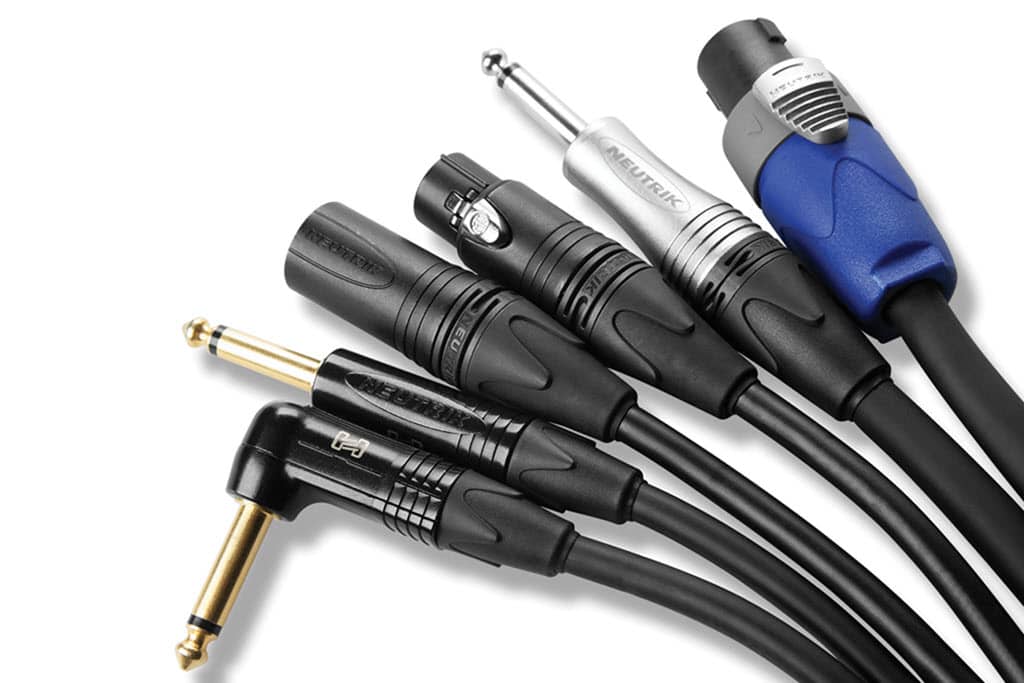When you are setting up your PA or recording system and sorting out the cables it is very helpful to know what the various connections are called…. particularly when you need to order more.
Here is a quick run-down on the main connector types and their uses.

XLR - 3 pin
Sometimes also called “Cannon” connectors (after the company that developed them). Very common for microphones and “balanced” inputs or outputs. Outputs are usually “male”, inputs are usually “female”.


Jack Plugs
Very common for many connections including instruments. There are two types seen in audio systems:
- TS (Tip, Sleeve) – normal mono connection
- TRS (Tip, Ring, Sleeve) – stereo or “balanced” connection
Jack plugs also come in 2 common sizes:
- 1/4” or 6.35mm (guitar jack size) … most common size in professional audio systems
- 1/8” or 3.5mm (mini-jack) … most common size in domestic hifi and portable audio devices

RCA Plugs
Original name is Cinch plug and also known as Phono plug, but the common name now is RCA…. named after the company that developed them (Radio Corp of America).
Very popular in domestic hifi systems and A/V systems (Yellow RCA plugs are commonly used for composite video signals on DVD players, TVs, video projectors and audio/video breakout cables for smart mobile devices).

SpeakOn
The Speakon connector (developed by Neutrik in Liechtenstein) is the current standard for speaker connections and features a simple locking sytem. The Speakon is available in 2, 4 or 8 pole formats.
Standard connections use only 2 poles (pins), but most plugs accept up to 4 (eg to separate signals to low frequency and high frequency speakers in a bi-amped system). Speakon is actually a registered trade mark of Neutrik although many copies flood today’s market place. Without question however, the Neutrik Speakon connectors are far superior in terms of construction and reliability.

Ethercon
The Ethercon connector (also developed by Neutrik) is the current standard for professional digital audio connections that use Cat5e or Cat6 Ethernet network cabling. This cabling is similar to standard IT network cabling, except that the connectors are heavy duty, extremely durable and reliable. They also have a locking mechanisim to avoid accidental removal … which would be disasterous in a major live performace or recording session. A single Ethernet cable can run many channels of digital audio in both directions.
It is also worth noting that Ethernet cable used with professional digital audio systems are very different in construction to standard network cables. They are “ruggedised” for rough handling and usually multi-stranded to maximise flexibility.

XLR-TRS Jack Combo Socket
While not a connector you will find on the end of a cable, the XLR-TRS Jack combo socket is widely used on audio equipment that accepts either XLR or TRS balanced connections (such as cables from microphones or or other professional audio components) as well as TS unbalanced connections (such as instrument cables). If you look closely you will see that the hole in the middle will accept a TRS or TS 6.35mm (1/4″) jack whereas the outer ring will accept a male XLR plug with the 3 pins just outside the centre hole.
Handy Hint ... just remember the letter "R"
RED Plugs
Whenever you purchase dual cables of virtually any configuration (eg dual RCA, dual TRS jacks, dual RCA to TS jacks, single TRS jack to 2 x RCA etc) you will generally find that one of the plugs is RED. The other plug is usually Grey, White or Black. The industry standard, when using these cables in a stereo application, whether in hifi or professional audio systems, is that the RED plug is the RIGHT channel … remember BOTH start with the letter “R”.
► RED = RIGHT channel.
When you have an INSERT cable … where there is a TRS jack at one end and 2 x TS jacks at the other end … again, one of the TS jacks will be RED, the other can be any colour (usually grey or black). The TIP of the RED TS jack is connected to the RING of the TRS jack (note that BOTH start with the letter “R” again). The RING is also the RETURN when used as an INSERT. The TIP of the other TS jack is connected to the TIP of the TRS jack. The TIP is the SEND when used as an INSERT.
► RED = RING = RETURN
The "R" in TRS
When you are using TRS (Tip, Ring, Sleeve) jacks in a stereo situation (also often called “stereo jacks” as used on headphones and a host of stereo inputs and outputs) the RING of the jack is always connected to the RIGHT channel. The TIP is the LEFT channel. That letter “R” again!
► RING = RIGHT



















